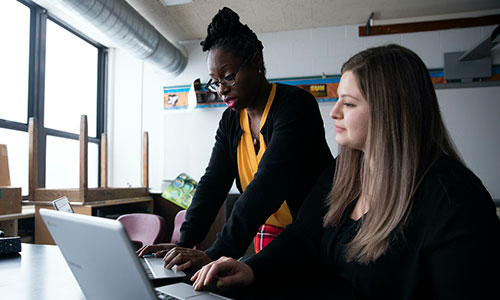
Like I mentioned in an earlier post, recent research on the effects of COVID-19 school closures has revealed that progress toward academic recovery for older kids has been slower than projected.
My job involves providing professional learning for teachers like you. When I bring up COVID-19 and learning loss, teachers are often frustrated. Because you already know that there is cause for concern! Since you know that your students have been affected (and will continue to be), I’ll leave you with a link to the research and jump into what you can do about it.
In our post “COVID-19 impacts: New data shows older students’ recovery needs attention,” our policy and advocacy team offers the following recommendations to state and district leaders:
- Use local data to guide recovery and invest in what works
- Expand instructional time by deploying evidence-based interventions and programs to the students who still need additional support
- Communicate the importance of academic recovery, sharing timely and relevant information with families
I think these recommendations can help you wrap your head around how to support students in your classroom, too.
How to make decisions based on data
To know where to even start, it helps to identify exactly where your students are in their learning. To uncover that, I recommend four specific actions:
- Use interim and formative assessments to determine areas of focus and adjust scope and sequence
- Teach grade-level content to all students
- Progress monitor using data
- Use the resources you have
Use interim and formative assessment
Assessment can help you determine areas of focus and adjust your scope and sequence.
When I was a high school English teacher, I thought I knew what my students needed when learning to write a great five-paragraph essay. I spent time going over the structure, discussing how to choose specific details, and working on carefully constructing inferences. One day, I was sharing the success we’d had so far at our vertical team meeting when I noticed the elementary teachers smiling. They then pulled out their anchor papers for fifth-grade writing; they were better developed than the essays I shared. I realized I’d forgotten to assess my students and that I had relied on my assumptions, rather than actual data, when I planned my instruction. The five-paragraph essay was in the high school curriculum, but we hadn’t vertically aligned, so our high school wasn’t aware that younger students were writing sophisticated essays in earlier grades, and we didn’t have interim or formative assessments either.
Data from interim assessments, like MAP® Growth™, provides details about where students are compared to their peers nationally. The data also provides each student’s zone of proximal development, or ZPD, relative to state standards. Knowing every kid’s ZPD helped me identify the instructional level for my students so that I could begin to differentiate and scaffold.
Formative assessment data provides touchpoints, too, so you can know you’re on the right path when you’re between interim assessment test events. Sometimes, I became overwhelmed thinking about how to formatively assess all my students, but I think that was mostly because I sometimes make formative assessment too difficult. There are digital formative assessment tools, exit slips, observations, and more. As long as we always remember that formative assessment is not for grading, it’s an invaluable tool, especially for showing us how COVID-19 school closures exacerbated existing gaps.
Teach grade-level content to all students
As you’re planning instruction, remember that we must (I’m going to say that again: we must) plan instruction on grade level. Our students will never be able to do grade-level work if they do not get grade-level instruction.
Ensure that instruction is not only at grade level but also at the appropriate level of rigor. If you are using MAP Growth, look to the RIT score to gauge the rigor of the progression of your standards. Depth of knowledge (DOK) is another indicator of rigor that can guide your decisions about grade-level instruction.
After you have planned-level instruction, use interim and formative assessment data to determine the students who need scaffolding. Learning loss is personalized, so we need scaffolding to be as well. Don’t assume students don’t have prerequisite skills unless the data indicates such. Consider a math lesson on y = mx + b as an example. In a class of 25, data shows five students will struggle with this concept. A close review of assessment data reveals those kids struggle with fractions, so their teacher now knows to preteach this small group about fractions, since fractions are a key component of the equation. When the teacher begins grade-level, whole-class instruction, everyone is able to understand it.
Progress monitor using data
Progress monitoring is critical—and even more so following COVID-19 school closures. However, you cannot monitor everything. Focus on key indicators or power standards.
Whenever we look at standards in particular, we’ll likely notice that there are some that spiral and some that must be secured in each grade level. Focus on the most critical standards and use data to monitor your students’ progress, adjusting instruction as needed. Don’t wait to adjust instruction after each semester. Instead, adjust right away if data indicates that interventions are needed or have been unsuccessful so far.
Do your best to also learn from progress monitoring. If something works, offer it to other students and classrooms. If something is not working, stop doing it and share your findings with others. Teaching can feel isolated, and I know I was often frustrated when I was failing to impact student learning. Eventually, I realized that I had the opportunity to learn from other teachers on professional development days, but I also realized that we shouldn’t have to wait that long. I wish that if my colleagues had found a strategy that worked for their students, they would have immediately shared their success so my students could also benefit.
Use the resources you have
We often fail to use some of the resources at hand. Curriculum materials usually have materials for enrichment and intervention aligned to standards. Yet when we would change curriculum materials at my school, I would often find these resources in the box, still shrink-wrapped. Check your closet, ask your curriculum department, and see what resources are available for interventions and enrichment. There might be so much more than you know is already available to you.
I encourage you to use your collaboration time well, too. Your colleagues can be some of your greatest resources.Some PLCs are highly structured to focus on data, interventions, and student needs. Others focus on field trips, supplies, and complaints. Could you lobby to do that second set of things via email or over happy hour? PLCs should be structured, follow an agenda, and focus on key learning, instructional strategies, and data. Each agenda item should have a set amount of time, and a timekeeper can help maintain focus. Help ensure that PLC time is used to discuss data, interventions, and student needs, instead of basic lesson planning (an easy enough trap to fall into, I know).
Finally, use technology resources to target student learning as best you can. Technology-based learning pathways can support student learning. Technology cannot be the only support for struggling students, however. Strong instruction by you—the teacher—is necessary to accelerate learning.
How to expand instructional time
We need to think about time differently. I mentioned this in my previous post, directed at administrators.
Teachers, here’s how to make every moment count: Use structures and procedures to ensure that students are engaged in learning from the beginning of class, like bell ringers to get students going with immediate learning. Consider having a peer observe your class to help you “find” time (it’s hard to know what we don’t know and see what we don’t see). Using efficient procedures for common tasks such as providing make-up work and returning assignments can buy back bits of time. For example, I knew a teacher who used folders with dates for make-up work assignments, and another organized assignments to be returned into student folders that students were responsible for gathering. I taught my students 174 days per year. Saving five minutes with a procedure would have resulted in 14.5 hours of additional instruction.
Getting ahead of something before it becomes a big problem helps with instructional time, too. If a student is struggling, intervene quickly. Don’t wait until the grading period ends to suggest tutoring or contacting caregivers. Similarly, if a student fails to turn in assignments or engage in learning, ask them why right away. I failed my junior year English class. I had not engaged in class for the entire semester because I did not understand a rigorous writing assignment I was given. I was in an honors-level course, and the teacher decided that I should be responsible for my own success. When I earned the failing grade, my mom found out at conferences, when it was too late for her to do much other than worry and be upset. Imagine if the teacher had contacted my mom earlier. Imagine how much more my teacher could have done to make the most of her instructional time with me if she’d stepped in sooner.
How to communicate with families
As teachers, we have been bombarded with information about learning loss. Some media sources have even used research on learning loss following COVID-19 school closures to attack teachers and schools. But we know parents and other caregivers tend to trust their student’s teacher. Therefore, we need to put pandemic-related learning loss in the context of each student.
During conferences, frame student learning within the broader context of learning loss. If I were sharing interim or state assessment data, for example, I would not only share where a student was, using the national norms, but I would also share the data related to learning loss.
Create a partnership with parents and guardians to support accelerating learning. Give them something specific they can do at home to support learning and explain why it will be helpful. I remember my daughter was assigned to read 20 minutes a night when she was in elementary school. I complied, but I never really understood why I should. The teacher forgot to explain that 20 minutes of reading a day builds vocabulary and background knowledge.
Finally, assume that caregivers want what is best for their child. We’re on the same team. Be a good teammate by improving communication. Talk transparently about the importance of academic recovery. Listen, too. What is not said is often just as important as what is said, so hear what’s between the lines and know that parents believe they are doing what is best for their child.
Closing thoughts
I know teachers are frustrated with learning loss following COVID-19 school closures. The pandemic has had undeniable academic and social impacts in schools. We must think differently about data, time, and communication to support academic growth.







